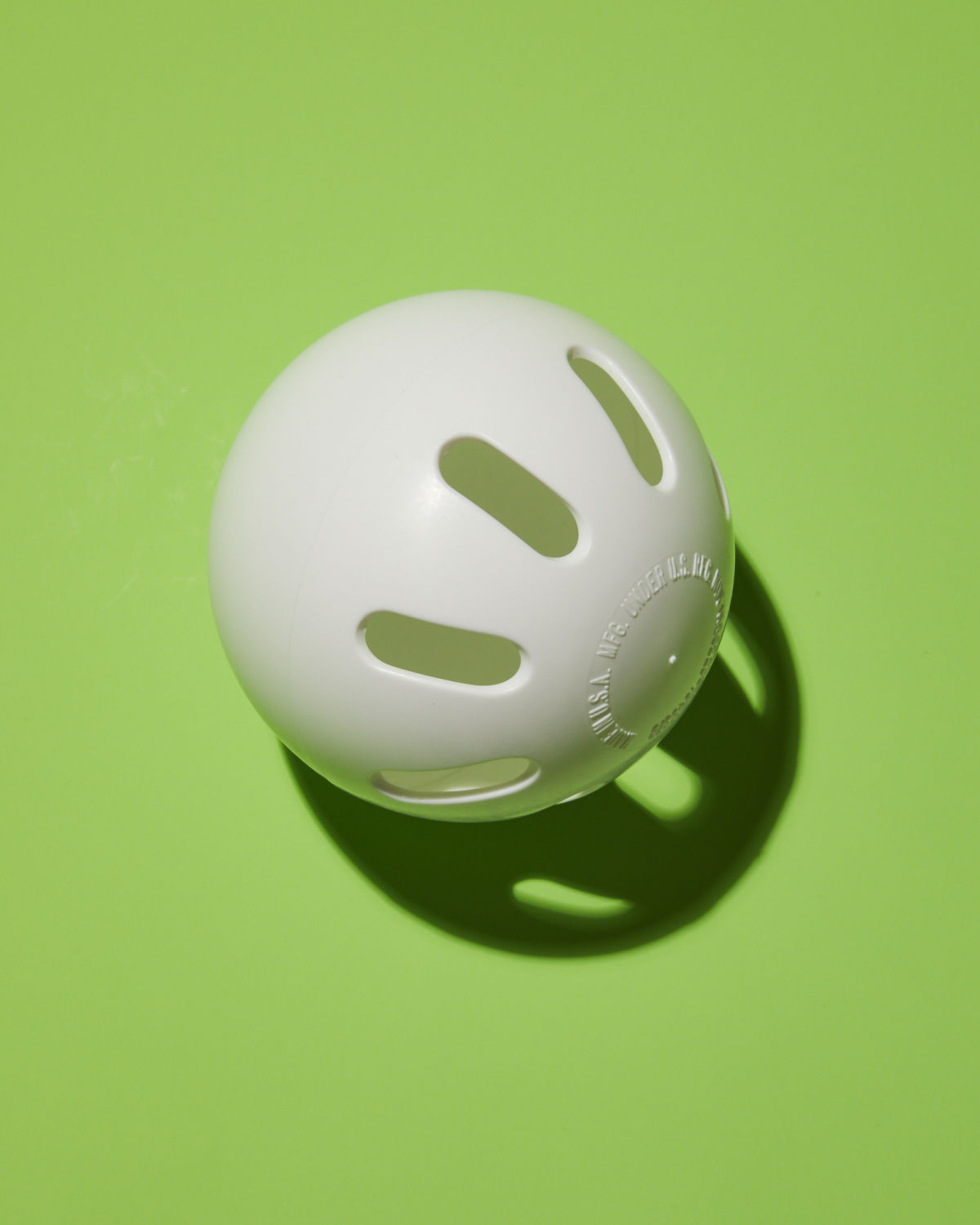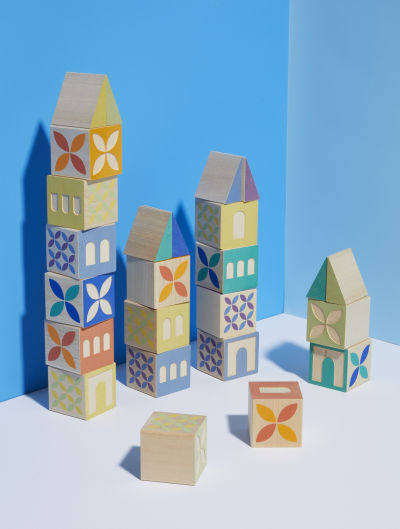A writer answers his son’s pressing questions on the enduring toys that link their childhoods
Story by Joshua David Stein • Photography by Victor Prado
Some of the most popular toys in America today are the same ones your parents and grandparents played with when they were kids. They may be simple, but they still command our attention—and our curiosity. Here, a writer answers his sons’ burning questions about eight American classics.

Q: IF YOU MISS A WIFFLE BALL, IS IT STILL CALLED WHIFFING?
A: According to David J. Mullany, the third-generation president of Shelton, Connecticut–based Wiffle Ball Inc., that’s the point. “My grandfather called it a Wiffle Ball because it’s hard to hit,” Mullany says. Back in the summer of 1953, the eldest Mullany, a former semipro baseball pitcher, was watching his 12-year-old son and his friend tire their arms out throwing curveballs with a plastic golf ball. (After numerous broken windows, they’d been forbidden from using regular baseballs.) David Sr. didn’t want the kids to hurt their arms, so he started playing around with some round plastic pieces from perfume packaging, eventually settling on a design—a hollow plastic ball with eight holes cut into the sides—that was easy to curve, but couldn’t travel fast enough to break anything.

Q: HOW DO CRAYOLA CRAYONS GET THEIR COLOR?
A : The 12 million crayons Crayola makes every day at its factory in Easton, Pennsylvania, actually start as colorless wax. After the wax is heated, pigment—a colorful powder—is added, and the colored wax is poured into crayon-shaped molds to cool. Four to seven minutes later, a crayon is born.The very first crayon box, sold in 1903, had only eight colors—red, orange, yellow, green, blue, violet, brown, and black—and the 120 colors available today are all variations on these original shades. Starting in 1993, the company gave fans the chance to name some of the new colors, and many names, including Macaroni and Cheese and Tickle Me Pink, have come from kids!
Q: IS SILLY PUTTY A SOLID OR A LIQUID?
A: Believe it or not, Silly Putty is a special type of liquid. When the slime was first introduced in toy stores in 1950, it was advertised as “The Real Solid Liquid.” Huh? According to Dr. John Nychka, a professor of engineering at the University of Alberta, in Canada, who has spent his career studying the properties of Silly Putty (among other things), Silly Putty is “a non-Newtonian dilatant viscoelastic liquid.” Double huh? What Dr. Nychka means is that Silly Putty sometimes acts as a liquid while at other times, it behaves like a solid, depending on the force applied. If you pull a wad of Silly Putty apart quickly, it snaps like a solid. If you pull gently, it stretches and oozes, like a liquid.
Q: ARE BERLIN FLYER WAGONS MADE IN BERLIN, AND DO THEY FLY?
A : Berlin Flyer wagons are indeed made in Berlin—Berlin, Ohio, not Berlin, the capital of Germany. Berlin, Ohio, gets its name from its large community of Amish people, a religious group that originally hailed from Germany and that today is devoted to living simply, without many modern conveniences (for example, you might see them driving a horse and buggy instead of a car). In fact, Berlin Flyer wagons have been hand-made by Amish craftspeople since the early 1970s. And while the wagons can go pretty fast, unfortunately they don’t fly. According to Tricia Raber, the accountant at Berlin Flyer, “They’re called flyers because the steering is so smooth, it feels like you’re flying.”
Q: HOW DOES A SLINKY “WALK”?
A : A Slinky is really just a long, thin wire (or piece of plastic, since the early 1970s) bent into a tight spring of up to 80 coils.This coiling is what gives the Slinky its many magical properties and makes it “walk” on its own when you knock it down the stairs. As gravity begins pulling the Slinky down the stairs, the force of that motion continues as a wave of energy that travels through the Slinky and stops once it reaches the bottom. And when dropped from a great height, a Slinky will appear to float in midair for a second, because the forces of the spring pulling upward and gravity pulling the Slinky downward briefly cancel each other out.
Q: WHICH WAR ARE ARMY MEN FIGHTING?
A : Before these little green men fought the battles of your imagination, they were modeled after real-life American soldiers—but these soldiers have been shrunk until they’re 35 times smaller. “The first Tim Mee men were soldiers from World War II, but the best-known are from the Vietnam War,” explains Jeff Imel, who commissions the production and oversees the distribution of Tim Mee plastic army men, which are manufactured by Alpha International in Kalkaska, Michigan. In 1968, during the Vietnam War, Tim Mee was one of the first companies to update its soldiers’ equipment to match that of the soldiers in the field. But over the years, Tim Mee has expanded beyond little army men to space invaders, dinosaurs, and even firefighters—making mission possibilities limitless.

Q: ARE WOODEN BLOCKS ALWAYS SQUARE?
A: Just because wooden blocks are usually square—or technically, cubes, which are three-dimensional squares—doesn’t mean they have to be. In Grand Rapids, Michigan, Uncle Goose makes triangular blocks (for building city rooftops or bridges) as well as elephant-, zebra-, and giraffe-shaped blocks. But the company’s square blocks are still cool—Uncle Goose even has its own writer, creative director Sarah Crookston, who figures out what they should say. “The ideas come easy,” she says. Crookston has helped make alphabet blocks in 23 different languages, from Hindi to Cherokee, plus block sets that explain the phases of the moon or tell the stories of brave women throughout history, from Supreme Court Justice Ruth Bader Ginsburg to poet Emily Dickinson.
Q: CAN YOU LIVE IN A HOUSE MADE OF LINCOLN LOGS?
A : Short answer—yes, or, at least, you can visit a building made with life-size Lincoln Logs. These toy construction sets were invented by John Lloyd Wright, the younger son of famous architect Frank Lloyd Wright, in 1916. John was inspired by a real building his father designed: the Imperial Hotel in Tokyo, Japan, which you can see today at the Meji-mura architectural museum. Frank Lloyd Wright’s design for that hotel used large wood beams that were notched on the ends so that they fit together. These beams helped inspire John’s design of his wooden Lincoln Logs, which today are made in Burnham, Maine, from maple wood. Like the Imperial Hotel, which survived a huge earthquake in 1923, Lincoln Logs’ notched design, also common in American log cabins, makes them super sturdy.